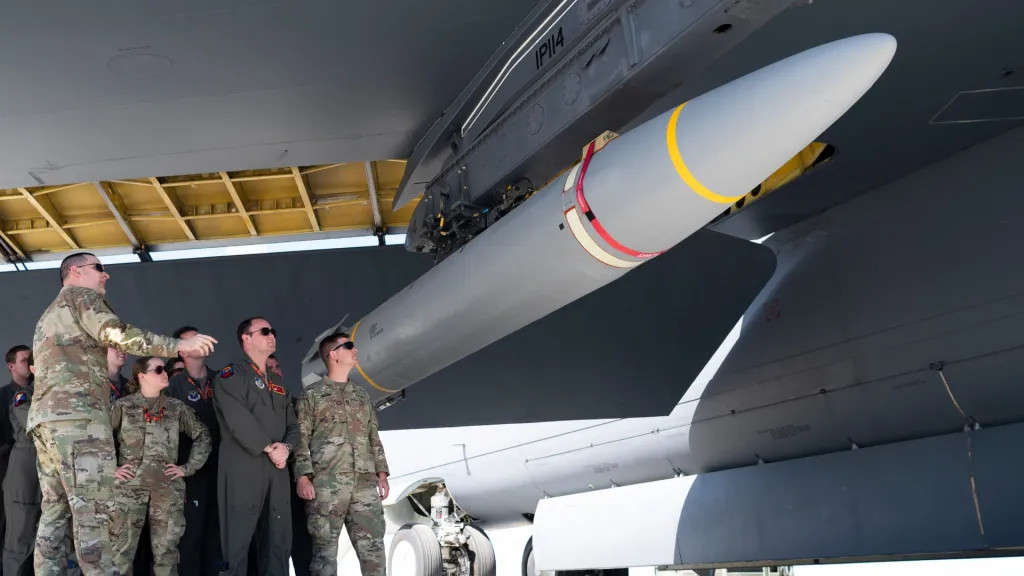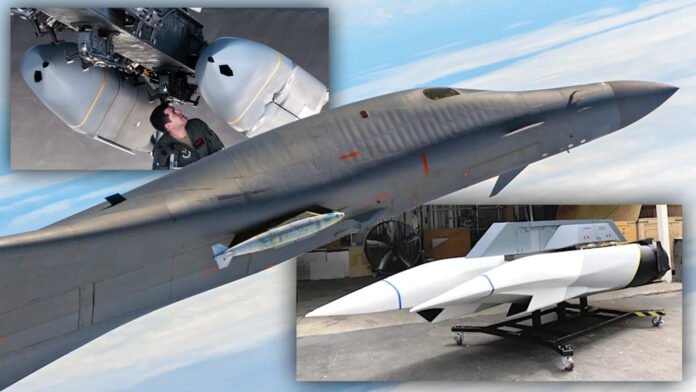The U.S. Air Force is moving ahead to add new external pylons onto its B-1B Lancer bombers after years of experimentation. The pylons will enhance the B-1’s already significant ability to carry large and diverse payloads, with a particular eye toward future hypersonic weapons. It is also a hedge against potential delays in the arrival of stealthy B-21 Raiders, which are set to replace the remaining Lancers.
In its recently released proposed budget for the 2026 Fiscal Year, the Air Force is asking for just over $50 million for the External Heavy-Stores Pylon program, which it says is a “new start” effort. There are currently 42 B-1s in active service, according to the latest budget documents. This is in part due to the total loss of one of the bombers in a crash at Ellsworth Air Force Base in South Dakota last year. The service is working to plus the fleet back up to 44 aircraft in the upcoming fiscal year.

The “External Heavy-Stores Pylon program expands on the accomplishments of the Hypersonic Integration Program, a Congressional
Add, by providing increased carriage capacity of standoff munition [sic] on B-1B aircraft,” the Air Force’s latest budget request explains. “Maximum carriage of existing standoff munitions on the B-1B provides near-term increased volume of fires from standoff ranges and serves to mitigate transition risk of the Air Force bomber fleet prior to the emergence of the B-21 as a combat bomber.”
“The Hypersonic Integration Program successfully demonstrated the B-1’s ability to execute a captive carry of a 5,000-pound class store and the release of a proven weapon shape from a Load Adaptable Modular (LAM) pylon,” the budget documents also note.
How many LAMs each B-1 will be fitted with is unclear. However, Air Force experimentation efforts in recent years have leveraged six existing hard points found on each Lancer, which were originally included in the design to allow the aircraft to carry nuclear-tipped cruise missiles externally. The hard points largely fell into disuse following the post-Cold War decision to eliminate the B-1’s nuclear capabilities, though the bombers do now use one of those stations to carry a Sniper Advanced Targeting Pod (ATP).



LAM is a design that Boeing has been working on since at least 2023. The company has said in the past that the pylon can be configured for loads up to 7,500 pounds, but it is unclear what weight limit the Air Force may now be targeting. The funding the service is asking for in the upcoming fiscal cycle looks set to go, in part, to answering that question.



Conducting “Computational Fluid Dynamic (CFD) and wind tunnel testing of pylon/weapon combinations” is among the Air Force’s stated goals for the External Heavy-Stores Pylon program in Fiscal Year 2026. The service also hopes to “begin hardware design to include changes to aircraft Line Replaceable Units (LRUs) and wiring” and “begin software updates to recognize pylon stations and weapons.”
With a 7,500-pound rating, the LAM could enable the B-1 to carry the AGM-183A Air-Launched Rapid Response Weapon (ARRW), a hypersonic weapon designed to launch an unpowered boost-glide vehicle, which you can read more about here. Air Force plans to move ahead with purchases of ARRWs have also notably re-emerged in the Fiscal Year 2026 budget proposal. The service had moved to cancel the AGM-183A in 2023, and refocus resources on the development of the air-breathing Hypersonic Attack Cruise Missile (HACM), but there were steady signs afterward that there was still life left in the ARRW program. ARRW testing to date has been conducted using B-52 bombers as launch platforms.

The HACM program is also still ongoing and could be another future addition to the B-1’s arsenal. Past reports have said that B-1s fitted with pylons might be able to carry up to 31 hypersonic weapons, in total, externally and internally.


Even just with a 5,000-pound rating, the pylons would allow B-1s to carry a significant array of existing and future munitions underneath their fuselages. In its 2026 Fiscal Year budget request, the Air Force is also notably seeking funding to begin integration of the C-3 variant of the AGM-158C Long-Range Anti-Ship Missile (LRASM). AGM-158C-3, which the U.S. Navy is leading development of, is set to have roughly twice the range of the current standard C-1 version (around 600 miles versus 200-300 miles based on available information), and feature other improvements that you can learn more about here.

The B-1 is currently the only Air Force aircraft certified to employ any version of AGM-158C, though the service is moving to give its F-15E Strike Eagles, F-15EX Eagle IIs, and F-16 Vipers that capability. Armed with LRASMs, the Lancers are formidable anti-ship assets, something that is expected to be particularly valuable in any future high-end fight in the Pacific with China.

The B-1 is also a key launch platform for variants of the AGM-158 Joint Air-to-Surface Standoff Missile (JASSM) land-attack cruise missile, from which LRASM is derived. A super-sized XR version of the JASSM is also now in development, which might be another future addition to the bomber’s arsenal.

A B-1 can currently carry up to 24 JASSMs or LRASMs internally. Based on weight, at least, six LAM pylons could allow the bombers to carry 12 more of those missiles, substantially increasing their overall load. JASSM and LRASM are expected to be key standoff munitions for the foreseeable future, with the Air Force looking to buy 389 and 118 of them, respectively, in the 2026 Fiscal Year. The service has also reportedly included a call for even more funding to dramatically increase production of those missiles in its annual Unfunded Priority List (UPL). By law, all branches of America’s armed forces and other elements of the U.S. military are required to submit UPL ‘wish lists’ to Congress every year.
New external pylons for the B-1 might also be paired with smaller and lower-cost standoff munitions the Air Force is now pursuing, all of which would expand the bomber’s already substantial magazine depth.
The aforementioned prospect of a major conflict with China in the Pacific has been a major driver behind Air Force efforts to expand its overall capacity to launch standoff strikes. This, in turn, has helped further fuel interest in cheaper standoff munitions to complement more exquisite types like the JASSM and LRASM.
In a high-end fight in the Pacific, B-1s would be tasked with conducting standoff strikes against enemy naval surface action groups and targets on the shore. Expanding the magazine capacity of each bomber increases the total engagement opportunities per sortie, which will be critical considering the distances involved, as well as the high maintenance needs of these aircraft.
It’s also worth noting that, while the Air Force’s stated focus for the new pylons is on increasing the B-1’s standoff strike capacity, the bombers could also use them to carry other types of munitions, especially for missions in lower-risk environments. The Lancer was heavily employed for close air support (CAS) sorties in permissive airspace during the Global War on Terror era.
As the Air Force’s latest budget request notes, the new pylons for the B-1s are also intended, in part, to help hedge against any potential trouble with the B-21. Air Force officials and members of Congress have repeatedly stated that the B-21 program is a model acquisition effort, but problems are known to have emerged in the past. Other factors have the potential to impact Raider delivery timetables, as well. Prime contractor Northrop Grumman has announced significant financial losses on the program in recent years, which it has blamed heavily on inflation and other macroeconomic disruptions.

The Air Force is also pursuing additional upgrades for the B-1 to help ensure the bombers remain operationally relevant in the interim. This includes an update to or replacement for the AN/ALE-50 towed decoys the bombers currently use to help shield them against incoming radar-guided missiles, as well as improvements to the bomber’s communications suite.
Another planned new start for Fiscal Year 2026 is a hybrid satellite communications systems that will allow for “securing alternate network connectivity and pathways [that] will restore long-range integration capability and increase combat effectiveness through a modern, resilient, and reliable construct,” with a particular eye toward future operations in the Indo-Pacific region. The Air Force is also seeking new funding to increase the readiness of its B-1 test force to support ongoing modernization efforts.
There is no change in the Air Force’s ultimate plans to retire the B-1 and replace those bombers with B-21s. As it stands now, the B-21 is still set to begin entering operational service sometime later this decade. Ellsworth in South Dakota is set to be the first base to host operational Raider units, as well as serve as the training hub for the bombers.
In the meantime, the B-1 fleet is getting new pylons and other improvements as the Air Force looks to squeeze as much capability as it can from the bombers in the twilight of their careers.
Update, 4:55 PM Eastern:
Boeing has now put out a press release about the pylon plans for the B-1, which includes additional details.
“This initiative saved over two years of development time, speeding increased combat capability to the flight line while allowing the B-1 to increase 50% of its current weapons payload capacity with larger and heavier weapons,” according to the release. “Each B-1 can accommodate six pylons, each capable of loading two 2,000-pound-class weapons or a 5,000-pound-plus-class future weapon. The Air Force intends to use the B-1 and pylons to test hypersonic weapons in the near term.”
“Our team identified an opportunity to help the U.S. Air Force achieve their mission even more effectively,” Troy Dawson, Bombers Development Vice President at Boeing, said in an accompanying statement. “They found a creative and innovative way to get new capability to the warfighter to stay ahead of current and emerging threats. They helped ensure the B-1 will be a key part of the U.S. bomber force for decades to come.”
“The pylon provides more mass and flexibility in rapidly evolving combat environments,” Dawson added. “When operational with the fleet, the LAM Pylon will allow the B-1, already packing the largest weapon load in the Air Force, to make an even bigger contribution to U.S. global striking power.”
“Testing proved that our rapid development met the Air Force requirements,” Dan Ruder, Bombers Advanced Programs manager at Boeing, also said in a statement. “We know that this type of innovation can be a vital asset for the U.S. Air Force and help the B-1 platform continue to adapt to evolving operational needs.”
Contact the author: joe@twz.com


























